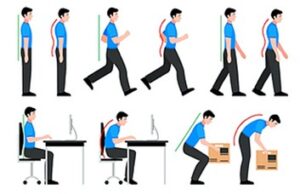In most motor tasks, posture and movement must be coordinated to achieve a desired function. To understand why and how this coordination occurs, it is important to precisely define posture and explore how this influences movement.
What is posture?
Posture is defined as the body segments’ configuration at any given time, or in simpler terms, the position in which someone holds their body, when standing and sitting.
In everyday tasks, the body takes on (1) antigravity control, which is the formation of the body segments holding and existing against gravity, and (2) the interface theory of perception and action which is controlling the relationship between the internal body and the external world.
There are several factors which influence posture:
- Genetic conditions that affect spinal and pelvic shape.
- Workplace, sport, and daily living injuries which affect your ability to perform movement e.g., limping from a broken foot.
- Overuse of different parts of the body resulting from repeated tasks at work or home.
- Enduring ‘bad’ posture.
‘Good’ vs ‘Bad’ Posture
The key to good posture is the position of your spine. Your spine has three natural curves at your neck, mid back, and lower back. Correct posture should maintain these curves without increasing them – your head should be above your shoulders and the top of your shoulders should be over your hips.

How Posture Affects Movement
Poor posture can interfere with the ‘slow twitch’ and ‘fast twitch’ muscle fibres, the muscle strength and length and the nervous system feedback on the body’s position in space. With postural dysfunction, the body often struggles and compensates safe movements for movements which are easier to articulate, including the incorrect use of muscle fibres. Fast twitch fibres exist in shallow muscles of the body and are usually used for movement and activity as they fatigue quickly. Slow twitch fibres exist in deeper muscle layers and sense our position in space for longer periods, which allows them to help maintain posture without too much effort.
Methods to Improve General Posture
The complications of poor posture can include back and neck pain, spinal dysfunction, joint degeneration, rounded shoulders, and respiratory weakness. Methods to improve posture include regular exercise and stretching, ergonomic furniture, practicing safe movements for change in posture and paying attention to the way your body feels.
Engaging with regular resistance exercise strengthens and supports muscles in your core, back and pelvis. Additionally, increasing flexibility assists with correcting muscular imbalances to improve alignment. By combing these two types of exercise, your range of motion is likely to improve, allowing sitting and standing in certain ways to be easier and less restrictive.




